Results 1-10 of 10
<<< Previous 1 Next >>>
![The Garden Rose. [&] The Wild Rose.](img-thumbnail/jpegs/48094.jpg)
The Garden Rose. [&] The Wild Rose.
Designed & Engraved by Henry Richter.
Published Sept.r 1799 by J.& H. Richter, 26 Newman Street, Oxford Street.
A pair of hand-coloured stipples. Sheet: 430 x 340mm (17 x 13½''). Borders messy. Cut to platemark.
A rare & decorative pair of scenes, one shows a young, well-dressed woman sitting in her cultivated garden while the second shows a girl in rags collecting wild roses. Title in English and French.
[Ref: 48094] £550.00
view all images for this item
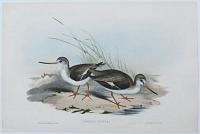
Terekia Cinerea.
J. Gould and H.C. Richter del et lith.
Hullmandel & Walton Imp. [n.d. c.1848.]
Hand-coloured lithograph. 368 x 552mm. 14½ x 21¾".
The Terek Sandpiper found along the water's edge and preferring muddy areas. The bird is named after the Terek River which flows into the west of the Caspian Sea, as it was first observed around this area. In Australia they are known as Australian Godwits. From 'Birds of Australia' by John Gould and Henry Constantine Richter. Known as 'the Bird Man', John Gould (1804-1881) was a naturalist whose passion was the field of ornithology. He was inspired to work on Australian birds by the many 'strange and unusual' specimens sent to him by his two brothers-in-law, who had emigrated to Australia in the early 1830s. He therefore relinquished his post at the Zoological Society and travelled to Australia in 1838 to record the 'habits and manners of its birds in a state of nature' - in country that was then largely unchartered. The expedition resulted in Gould discovering over 300 species; although many of these were later deemed to be subspecies, many of his bird names have survived to this day. "The Birds of Australia", issued in 36 Parts between 1840 and 1848. It is a massive work comprising 8 folio sized volumes that depict and describe all of the 681 Australian bird varieties then known, many of them recorded by Gould himself for the first time.
[Ref: 27102] £150.00
(£180.00 incl.VAT)
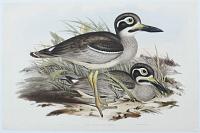
Esacus Magnirostris.
J. Gould and H.C. Richter del et lith.
Hullmandel & Walton Imp. [n.d. c.1848.]
Hand-coloured lithograph. 362 x 552mm. 14¼ x 21¾".
The Beach Stone-curlew, also known as Beach Thick-knee. It is one of the world's largest shorebirds and is found along the eastern coast of Australia, and as far south as far eastern Victoria and the northern Australian coast. From 'Birds of Australia' by John Gould and Henry Constantine Richter. Known as 'the Bird Man', John Gould (1804-1881) was a naturalist whose passion was the field of ornithology. He was inspired to work on Australian birds by the many 'strange and unusual' specimens sent to him by his two brothers-in-law, who had emigrated to Australia in the early 1830s. He therefore relinquished his post at the Zoological Society and travelled to Australia in 1838 to record the 'habits and manners of its birds in a state of nature' - in country that was then largely unchartered. The expedition resulted in Gould discovering over 300 species; although many of these were later deemed to be subspecies, many of his bird names have survived to this day. "The Birds of Australia", issued in 36 Parts between 1840 and 1848. It is a massive work comprising 8 folio sized volumes that depict and describe all of the 681 Australian bird varieties then known, many of them recorded by Gould himself for the first time.
[Ref: 27120] £320.00
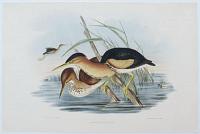
Ardetta Pusilla.
J. Gould and H.C. Richter del et lith.
Hullmandel & Walton Imp. [n.d. c.1848.]
Hand-coloured lithograph. 361 x 552mm. 14¼ x 21¾". Foxing upper right.
The Black-backed Bittern is one of the smallest herons in the world and is found in the southern parts of Australia from the Murray-Darling Basin to the Swan Coastal Plain. From 'Birds of Australia' by John Gould and Henry Constantine Richter. Known as 'the Bird Man', John Gould (1804-1881) was a naturalist whose passion was the field of ornithology. He was inspired to work on Australian birds by the many 'strange and unusual' specimens sent to him by his two brothers-in-law, who had emigrated to Australia in the early 1830s. He therefore relinquished his post at the Zoological Society and travelled to Australia in 1838 to record the 'habits and manners of its birds in a state of nature' - in country that was then largely unchartered. The expedition resulted in Gould discovering over 300 species; although many of these were later deemed to be subspecies, many of his bird names have survived to this day. "The Birds of Australia", issued in 36 Parts between 1840 and 1848. It is a massive work comprising 8 folio sized volumes that depict and describe all of the 681 Australian bird varieties then known, many of them recorded by Gould himself for the first time.
[Ref: 27107] £380.00
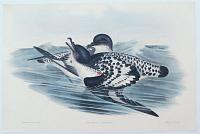
Daption Capensis.
J. Gould and H.C. Richter del et lith.
Hullmandel & Walton Imp. [n.d. c.1848.]
Hand-coloured lithograph. 368 x 552mm. 14½ x 21¾". Small tear on left. Fine.
The Cape Petrel, Cape Pigeon or Pintado Petral, is a seabird which breed in colonies on the Antarctic continent, but in the winter months they reach Australia. From 'Birds of Australia' by John Gould and Henry Constantine Richter. Known as 'the Bird Man', John Gould (1804-1881) was a naturalist whose passion was the field of ornithology. He was inspired to work on Australian birds by the many 'strange and unusual' specimens sent to him by his two brothers-in-law, who had emigrated to Australia in the early 1830s. He therefore relinquished his post at the Zoological Society and travelled to Australia in 1838 to record the 'habits and manners of its birds in a state of nature' - in country that was then largely unchartered. The expedition resulted in Gould discovering over 300 species; although many of these were later deemed to be subspecies, many of his bird names have survived to this day. "The Birds of Australia", issued in 36 Parts between 1840 and 1848. It is a massive work comprising 8 folio sized volumes that depict and describe all of the 681 Australian bird varieties then known, many of them recorded by Gould himself for the first time.
[Ref: 27170] £160.00
(£192.00 incl.VAT)
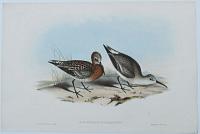
Schoeniclus Subarquatus.
J. Gould and H.C. Richter del et lith.
Hullmandel & Walton Imp. [n.d. c.1848.]
Hand-coloured lithograph. 368 x 554mm. 14½ x 21¾". Fine.
The Curlew Sandpiper, the small wader that breeds on the tundra of Arctic Siberia. In Australia, Curlew Sandpipers occur around the coasts and are also quite widespread inland, though in smaller numbers. From 'Birds of Australia' by John Gould and Henry Constantine Richter. Known as 'the Bird Man', John Gould (1804-1881) was a naturalist whose passion was the field of ornithology. He was inspired to work on Australian birds by the many 'strange and unusual' specimens sent to him by his two brothers-in-law, who had emigrated to Australia in the early 1830s. He therefore relinquished his post at the Zoological Society and travelled to Australia in 1838 to record the 'habits and manners of its birds in a state of nature' - in country that was then largely unchartered. The expedition resulted in Gould discovering over 300 species; although many of these were later deemed to be subspecies, many of his bird names have survived to this day. "The Birds of Australia", issued in 36 Parts between 1840 and 1848. It is a massive work comprising 8 folio sized volumes that depict and describe all of the 681 Australian bird varieties then known, many of them recorded by Gould himself for the first time.
[Ref: 27146] £180.00
(£216.00 incl.VAT)
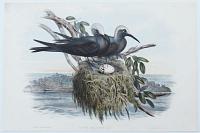
Anoüs Melanops: Gould.
J. Gould and H.C. Richter del et lith.
Hullmandel & Walton Imp. [n.d. c.1848.]
Hand-coloured lithograph. 368 x 557mm. 14½ x 22". Fine.
The Australian Lesser Noddy is often considered to be the same species as the Black Noddy, and is usually found only around its breeding islands in the Houtman Abrolhos Islands in Western Australia. From 'Birds of Australia' by John Gould and Henry Constantine Richter. Known as 'the Bird Man', John Gould (1804-1881) was a naturalist whose passion was the field of ornithology. He was inspired to work on Australian birds by the many 'strange and unusual' specimens sent to him by his two brothers-in-law, who had emigrated to Australia in the early 1830s. He therefore relinquished his post at the Zoological Society and travelled to Australia in 1838 to record the 'habits and manners of its birds in a state of nature' - in country that was then largely unchartered. The expedition resulted in Gould discovering over 300 species; although many of these were later deemed to be subspecies, many of his bird names have survived to this day. "The Birds of Australia", issued in 36 Parts between 1840 and 1848. It is a massive work comprising 8 folio sized volumes that depict and describe all of the 681 Australian bird varieties then known, many of them recorded by Gould himself for the first time.
[Ref: 27161] £320.00
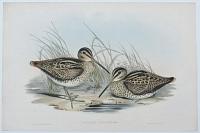
Scolopax Australis: Lath:
J. Gould and H.C. Richter del et lith.
Hullmandel & Walton Imp. [n.d. c.1848.]
Hand-coloured lithograph. 372 x 559mm. 14¾ x 22".
Commonly called New Holland Snipes. From 'Birds of Australia' by John Gould and Henry Constantine Richter. Known as 'the Bird Man', John Gould (1804-1881) was a naturalist whose passion was the field of ornithology. He was inspired to work on Australian birds by the many 'strange and unusual' specimens sent to him by his two brothers-in-law, who had emigrated to Australia in the early 1830s. He therefore relinquished his post at the Zoological Society and travelled to Australia in 1838 to record the 'habits and manners of its birds in a state of nature' - in country that was then largely unchartered. The expedition resulted in Gould discovering over 300 species; although many of these were later deemed to be subspecies, many of his bird names have survived to this day. "The Birds of Australia", issued in 36 Parts between 1840 and 1848. It is a massive work comprising 8 folio sized volumes that depict and describe all of the 681 Australian bird varieties then known, many of them recorded by Gould himself for the first time.
[Ref: 27108] £420.00
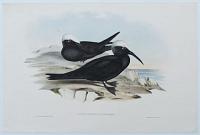
Anoüs Leucocapillus: Gould.
J. Gould and H.C. Richter del et lith.
Hullmandel & Walton Imp. [n.d. c.1848.]
Hand-coloured lithograph. 366 x 552mm. 14½ x 21¾". Fine.
The Black Noddy or White-capped Noddy, a seabird found in tropical and subtropical areas. From 'Birds of Australia' by John Gould and Henry Constantine Richter. Known as 'the Bird Man', John Gould (1804-1881) was a naturalist whose passion was the field of ornithology. He was inspired to work on Australian birds by the many 'strange and unusual' specimens sent to him by his two brothers-in-law, who had emigrated to Australia in the early 1830s. He therefore relinquished his post at the Zoological Society and travelled to Australia in 1838 to record the 'habits and manners of its birds in a state of nature' - in country that was then largely unchartered. The expedition resulted in Gould discovering over 300 species; although many of these were later deemed to be subspecies, many of his bird names have survived to this day. "The Birds of Australia", issued in 36 Parts between 1840 and 1848. It is a massive work comprising 8 folio sized volumes that depict and describe all of the 681 Australian bird varieties then known, many of them recorded by Gould himself for the first time.
[Ref: 27133] £180.00
(£216.00 incl.VAT)
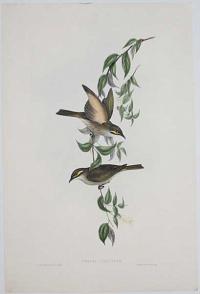
Ptilotis Chrysops.
J. Gould and H.C. Richter del et lith.
Hullmandel & Walton Imp. [n.d. c.1848.]
Hand-coloured lithograph. 552 x 368mm. 21¾ x 14½".
The Yellow-faced Honeyeater which is widespread across eastern and south-eastern Australia. They spend the winter in southern Queensland and then migrate to New South Wales and Victoria to breed. From 'Birds of Australia' by John Gould and Henry Constantine Richter. Known as 'the Bird Man', John Gould (1804-1881) was a naturalist whose passion was the field of ornithology. He was inspired to work on Australian birds by the many 'strange and unusual' specimens sent to him by his two brothers-in-law, who had emigrated to Australia in the early 1830s. He therefore relinquished his post at the Zoological Society and travelled to Australia in 1838 to record the 'habits and manners of its birds in a state of nature' - in country that was then largely unchartered. The expedition resulted in Gould discovering over 300 species; although many of these were later deemed to be subspecies, many of his bird names have survived to this day. "The Birds of Australia", issued in 36 Parts between 1840 and 1848. It is a massive work comprising 8 folio sized volumes that depict and describe all of the 681 Australian bird varieties then known, many of them recorded by Gould himself for the first time.
[Ref: 27085] £150.00
(£180.00 incl.VAT)
<<< Previous 1 Next >>>
![The Garden Rose. [&] The Wild Rose.](img-thumbnail/jpegs/48094.jpg)








